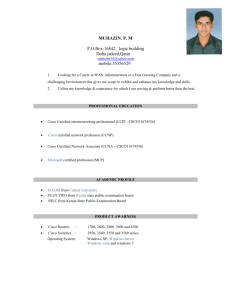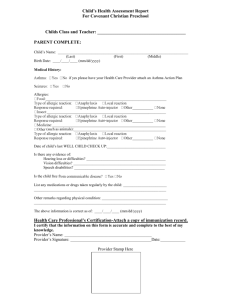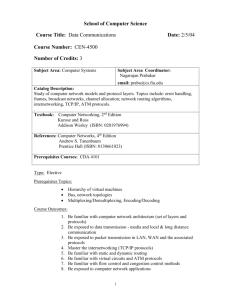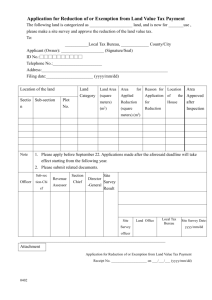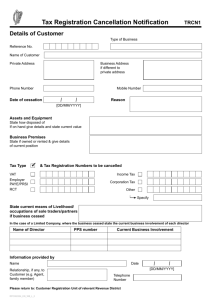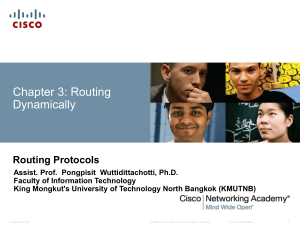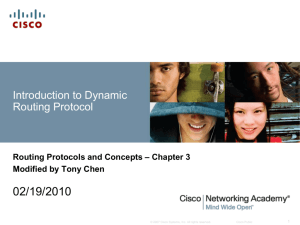CISCO Routers and Routing Basics
advertisement
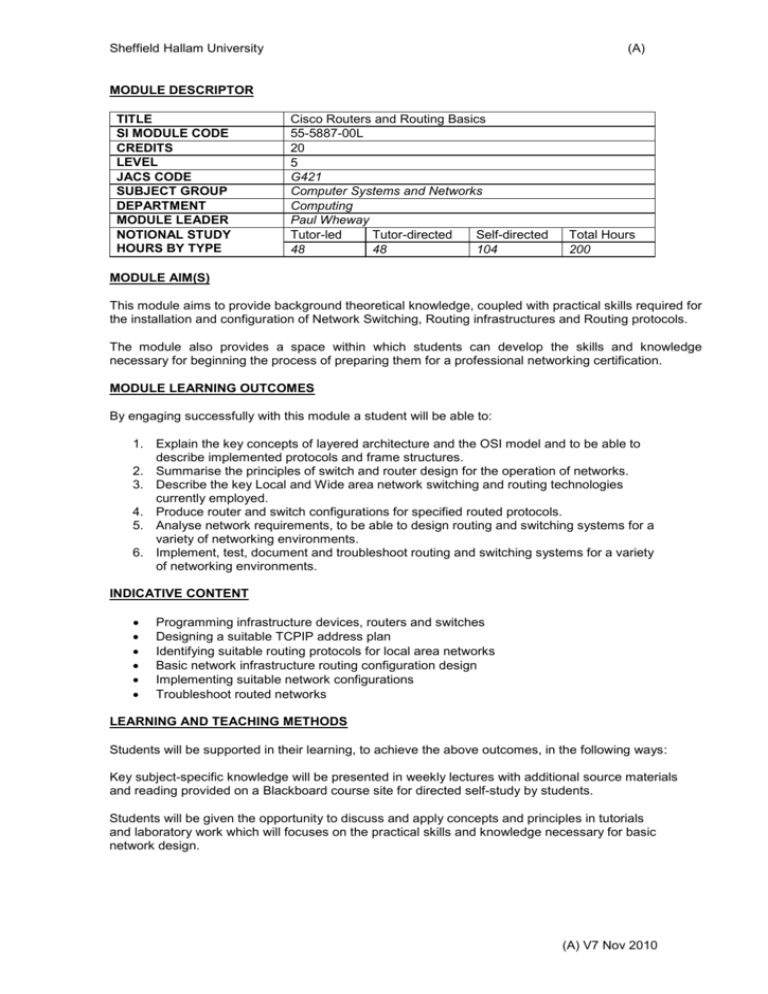
Sheffield Hallam University (A) MODULE DESCRIPTOR TITLE SI MODULE CODE CREDITS LEVEL JACS CODE SUBJECT GROUP DEPARTMENT MODULE LEADER NOTIONAL STUDY HOURS BY TYPE Cisco Routers and Routing Basics 55-5887-00L 20 5 G421 Computer Systems and Networks Computing Paul Wheway Tutor-led Tutor-directed Self-directed 48 48 104 Total Hours 200 MODULE AIM(S) This module aims to provide background theoretical knowledge, coupled with practical skills required for the installation and configuration of Network Switching, Routing infrastructures and Routing protocols. The module also provides a space within which students can develop the skills and knowledge necessary for beginning the process of preparing them for a professional networking certification. MODULE LEARNING OUTCOMES By engaging successfully with this module a student will be able to: 1. Explain the key concepts of layered architecture and the OSI model and to be able to describe implemented protocols and frame structures. 2. Summarise the principles of switch and router design for the operation of networks. 3. Describe the key Local and Wide area network switching and routing technologies currently employed. 4. Produce router and switch configurations for specified routed protocols. 5. Analyse network requirements, to be able to design routing and switching systems for a variety of networking environments. 6. Implement, test, document and troubleshoot routing and switching systems for a variety of networking environments. INDICATIVE CONTENT • • • • • • Programming infrastructure devices, routers and switches Designing a suitable TCPIP address plan Identifying suitable routing protocols for local area networks Basic network infrastructure routing configuration design Implementing suitable network configurations Troubleshoot routed networks LEARNING AND TEACHING METHODS Students will be supported in their learning, to achieve the above outcomes, in the following ways: Key subject-specific knowledge will be presented in weekly lectures with additional source materials and reading provided on a Blackboard course site for directed self-study by students. Students will be given the opportunity to discuss and apply concepts and principles in tutorials and laboratory work which will focuses on the practical skills and knowledge necessary for basic network design. (A) V7 Nov 2010 Sheffield Hallam University (A) ASSESSMENT STRATEGY AND METHODS This module will be assessed through coursework. All assessments will address all learning outcomes. Task No. TASK DESCRIPTION SI Code 1 2 Coursework Coursework CW CW Task Weighting % 50% 50% Word Count / Duration N/A N/A In-module retrieval available Y Y ASSESSMENT CRITERIA All assessments will address all learning outcomes and in order to pass the module you will: 1. 2. 3. 4. Be able to design a suitable TCPIP addressing structure Be able to describe processes to design a routed network infrastructure Be able to build and design a small routed network Be able to identify and explain routing protocols, and their use in modern network architectures FEEDBACK Students will receive feedback on their performance in the following ways: • The coursework will comprise of two parts. These will be scheduled at the end of each semester. The first will allow the tutor to provide feedback before progressing to the next stage. Feedback will be provided by an indicative score an example of what was expected as a model answer. • Formative feedback will be given throughout the module during laboratory sessions. Verbal feedback, supplemented by written notes if appropriate, will be given when each of these parts is marked. • Blackboard will be used to provide students with performance grades and assessment feedback, as well as additional information that may be requested as a result of student feedback throughout the progress of the module. LEARNING RESOURCES (INCLUDING READING LISTS) Additional information is available to support this module, including assessment criteria detailing how your performance in the module will be measured, how you will receive feedback, details of learning resources, and key reading. This information can be found either in the course handbook, or on the module's blackboard site. Due to the dynamic nature of this module the additional information including the reading list below is likely to change from year to year. Reading List to include: • CCNA Exploration Course Booklet: Network Fundamentals, Version 4.0, First Edition. Cisco Press. ISBN-13:978-1-58713-243-8 • CCNA Exploration Course Booklet: Routing Protocols and Concepts, Version 4.0, First Edition. Cisco Press. ISBN-13:978-1-58713-251-3 • Dooley, K., Brown, I. (2006). Cisco IOS Cookbook, Second Edition. Publisher: O'Reilly Media. ISBN REVISIONS Date July 2012 Reason Assessment Framework review (A) V7 Nov 2010 Sheffield Hallam University (A) SECTION 2 'MODEL A' MODULE (INFORMATION FOR STAFF ONLY) MODULE DELIVERY AND ASSESSMENT MANAGEMENT INFORMATION MODULE STATUS - INDICATE IF ANY CHANGES BEING MADE NEW MODULE N EXISTING MODULE - NO CHANGE Y Title Change N Level Change N Credit Change N Assessment Pattern Change N Change to Delivery Pattern N 9/2011 Date the changes (or new module) will be implemented MODULE DELIVERY PATTERN - Give details of the module delivery pattern. If the course has more than one intake, for example, September and January, please give details of the module start and end dates for each intake. Module Begins Module Ends Course Intake 1 DD/MM/YYYY DD/MM/YYYY Course Intake 2 DD/MM/YYYY DD/MM/YYYY Course Intake 3 DD/MM/YYYY DD/MM/YYYY Is timetabled contact time required for this module? Y Are any staff teaching on this module non-SHU employees? If yes, please give details of the employer institution(s) below N What proportion of the module is taught by these non-SHU staff, expressed as a percentage? MODULE ASSESSMENT INFORMATION Does the Module (using Model A Assessment Pattern) Require Either* Overall Percentage Mark of 40% Y Overall Pass / Fail Grade N *NB: Choose one of the above – Model A module cannot include both percentage mark and pass/fail graded tasks FINAL TASK According to the Assessment Strategy shown in the Module Descriptor, which task will be the LAST TASK to be taken or handed-in? (Give task number as shown in the Assessment Strategy) MODULE REFERRAL STRATEGY Task for Task (as shown for initial assessment strategy) Single Referral Package for All Referred Students Task No. 2 Y N (A) V7 Nov 2010
![Internetworking Technologies [Opens in New Window]](http://s3.studylib.net/store/data/007474950_1-04ba8ede092e0c026d6f82bb0c5b9cb6-300x300.png)



